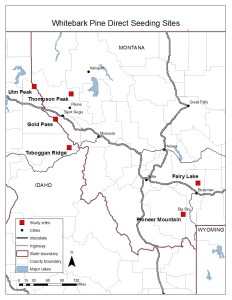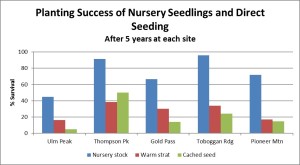2015 Whitebark Pine (WBP) Regeneration Strategies: Direct Seeding versus Planting Seedlings Evaluations: 2014 Evaluation and Monitoring
General Project Information
Project Title:
Whitebark Pine (WBP) Regeneration Strategies: Direct Seeding versus Planting Seedlings Evaluations: 2014 Evaluation and Monitoring
Project Dates: 2015
Year project implementation started: 2009
How many more years is this project expected to continue, if any?
Project Contact: (Please provide complete information for primary contact(s), e.g., name, position, phone number, email, agency name, unit/sub-unit)
Terrie Jain, USDA-FS RMRS, Moscow, ID
Paul Zambino, FHP, Coeur d’Alene Field Office, ID
Location (Land management agency or ownership and name of geographic area(s) where project was implemented. This information should be specific enough to identify a general project location on a map but not specific enough to compromise the project.)
Table 1. Location of direct seeding trials
| Study Area | Location | 20091 | Installation Date | Measurement Year | Measurement year | ||
| 20101 | 2012 | 20132 | 2014 | 2015 | |||
| Ulm Peak | Lolo NF, ID | Direct Seed
2-year seedling |
5-Year |
6-Year |
|||
| Thompson Peak | Lolo NF, MT | Direct Seed #1
2-year seedling |
Direct Seeding #2 | 5-Year 2009
1-Year 2013 |
6-Year 2009 2-Year 2013 |
||
| Gold Pass | Lolo NF, MT | Direct Seed#1
2-year seedling |
Direct Seeding#2 | 5-Year 2009
1-Year 2013 |
6-Year 2009 2-Year 2013 |
||
| Fairy Lake | Bozeman, MT | Direct Seed#1
2-year seedling |
5-Year | ||||
| Toboggan Ridge | Island Park, ID | Direct Seed#1
2-year seedling |
5-Year |
6-Year |
|||
| Yellowstone Club | Big Sky, MT | Direct Seed#1
2-year seedling |
5-Year |
6-Year |
|||
| Sawtell Peak | Island Park, ID | Direct Seed#1
2-year seedling |
2-Year |
— |
|||
| Teton Ski Area | Jackson Hole, WY | Direct Seed#1
2-year seedling |
2-Year |
— |
|||
1Direct seeding #1 was evaluating different direct seeding methods (refer to Table 2).
2Direct seeding #2 was evaluating different sowing times and sowing depths (refer to Table 2).
Figure 1. Map of the whitebark pine direct seeding sites established in Idaho and Montana in 2009 and 2010
(click on image to view full-size version)
Cooperators: (List cooperating agencies and sub-units, other companies/organizations, and individuals as needed.)
Project Funding
Funding Sources (amount FHP/amount other incl. in-kind)
Forest Health Protection funding $ 3,500
Other funding $ 7,000
Total $10,000
Did Whitebark Restoration funding get used or obligated? (If not, please explain.)
Yes, all funding was spent and a portion was obligated to pay for publication costs.
Project Details
Scope and/or Size of Project or Treated Area: (Include a short description of the project or treatment area if helpful in understanding the scope of the project.)
The scope/design of the project from 2009 to 2013 is specified in Table 2.
Table 2. Design for 2009, 2012 and 2013 direct seeding installations. Each regeneration technique is replicated 5 times on each site (Table 1). Two replicates of surface temperature in shade and full sun were also installed on each site.
| Installation Year | Direct Seed Evaluation | Seedling Evaluation | |
| 2009 & 2012 | Caged | No Cage | 2-year old seedlings |
| Stratified seed | Stratified seed | ||
| Scarified seed | Scarified seed | ||
| Stratified & scarified seed | Stratified & scarified | ||
| 2013 | Stratified seed
planted 0.75” & 1.5” depth |
Not-stratified seed planted 0.75” & 1.5” depth | 2-year old seedlings |
| Late July sowing | Late July sowing | ||
| Late August sowing | Late August sowing | ||
| Late September sowing | Late September sowing | ||
Number of Acres or Other Units Treated, Monitored, or Surveyed:
Small plots were spread across 5-10 acres at each site.
Specific location of project or treated area(s): (If desired, add more specific project location information here, e.g., UTMs, Lat-long, specific landmark. Otherwise, indicate if more information is available by request.)
Center of replications at Gold Pass: 47.230625 -115.313712
Center of replications at Thompson Peak: 47.747779 -114843439
Objective(s) (from original request):
Improve cost efficiency and increase potential attainable acreages of projects for restoring whitebark pine (Pinus albicaulis) across its range by optimizing direct seeding vs. seedling techniques for accomplishing regeneration.
- Determine planting window for operational field-sowing of seeds
- Determine optimum seed planting depths for field planting dates and sites
- Determine whether non-pretreated vs. warm-stratified seed are preferable for extended (non-fall) field-sowing
- Compare direct seeding vs. fall-planted “standard” vs. “stubby” seedlings
Planting: (Please answer the following questions if the project includes plantings or cone collections.)
Number of seedlings planted (List by location if applicable):
100 seedlings were planted at each site; two (2) next to each of the 50 direct seeding replications at the site. See Table 1 for locations.
Was the seed source screened for resistance? (If other, explain.)
No
Were Plus trees used?
Results/Outcome:
Germination (seedling emergence)
Although there was wide variation in germination levels observed between sites, some seed treatments consistently outperformed others (Table 3). Warm-stratified seed germinated best at 5 of 6 sites (> 50% average germination at 4 of 6 sites). Seed scarification was only beneficial at Yellowstone Club and was less successful than the untreated control seed on all other sites. The benefit of warm stratification was reduced when combined with scarification at 5 of 6 sites.
Germination of treated seed primarily occurred the first spring following planting; (e.g., 97% of warm-stratified seed germinated the first year) while nearly half (42%) of the untreated seed didn’t germinate until the second year. No seed germinated after the second year. Very little rodent predation of planted seed was observed either inside or outside cages.
The 2013 seed germination study was unsuccessful with less than 10% of the seeds germinating. We conclude from this outcome that weather conditions for germination were less favorable during and after 2013 and the year after planting regardless of site. Thus, success of direct seeding is most likely a function of weather conditions (moisture and temperature) that promote germination.
Table 3. Germination results from 2009 and 2010 germination tests.
| Site | Warm Strat | Scarify | Warm Strat & Scarify | Control | Ave Germ. |
| Ulm Peak | 52.3 | 11.1 | 43.0 | 30.0 | 34.1 |
| Thompson Peak | 56.0 | 24.1 | 58.8 | 37.9 | 44.2 |
| Gold Pass | 72.9 | 27.5 | 50.5 | 41.5 | 48.2 |
| Toboggan Ridge | 41.5 | 42.5 | 38.5 | 45.5 | 42.0 |
| Fairy Lake1 | 24.0 | 9.0 | 20.5 | 18.5 | 18.0 |
| Yellowstone Club | 51.0 | 48.5 | 40.0 | 29.5 | 42.1 |
| Ave (w/o Fairy Lk) | 54.7 | 30.7 | 46.2 | 36.9 | 42.1 |
| 1Fairy Lake was determined to be a limber pine site and was excluded from further analysis. | |||||
Germination results from 3-seed caches
The percent of seed that germinated from 3-seed caches was less than individual
warm-stratified seed germination at all sites except Thompson Peak (Table 4). This indicates that caching three seeds usually did not improve germination on the same sites.
Table 4. Number of 3-seed caches, total seeds planted, and percent germination of each.
| Site | # of 3-seed caches | % of 3-seed caches with ≥ 1 germinated seed | Total # of cached seeds | % of total seeds that germinated |
| Ulm Peak | 27 | 37.0 | 81 | 22.2 |
| Thompson Peak | 34 | 88.2 | 100 | 66.0 |
| Gold Pass | 36 | 50.0 | 108 | 32.4 |
| Toboggan Ridge | 100 | 49.0 | 300 | 29.3 |
| Yellowstone Club | 99 | 49.5 | 297 | 36.0 |
Survival of germinates
After germination, survival of germinates varied by site but not by seed treatment. In general, of the seeds that germinated, there was 40 to 80% survival, with Toboggan Ridge (Rdg) having the greatest survival followed by Thompson Peak. In both these cases, overstory trees (lodgepole pine) were present.
(click on graph to view full-size image)
Seedling survival in relation to direct seed survival
Seedlings were far more effective at surviving than direct seed after germination, even on the most adverse sites. For example, on the worse sites (Ulm Peak) there was over 40% survival and on the best sites, such as Thompson Peak and Toboggan Ridge, over 91% of the planted seedlings survived. In places where access is not limited and seedlings can be transported, planting seedlings appears to be the better option. However, direct seeding did not completely fail. Success is highly dependent upon post-planting weather that may favor germination. In addition, survival of on-site germinated seedlings (< 40%) was also much less even on the best sites.
Figure 2. Percent planting success of seedlings and direct seeding at each site after five years.
(click on graph to view full-size image)
Project Status (Is the project complete? If not, what remains to be accomplished and when?
The project is complete for the time being; we plan to wait 5 years and then revisit sites to evaluate seedling survival and growth. We will plan on preparing a formal publication on results in 2016 either in a refereed journal or Station Research Paper.
Will outcome meet objectives?
Yes, the objective was to evaluate direct seeding with planted seedlings and after 5 years we have determined that planting seedlings is still the preferred option due to better survival. Germination success is highly variable. The 2009 and 2010 direct seeding was moderately successful but the 2013 direct seeding failed. We infer from these results that post-planting weather most likely influenced the results. The two areas (Thompson Peak and Toboggan Ridge) that were the most successful in direct seeding and seedling survival, had standing dead which may have moderated the site favoring establishment and survival.
Project Follow-Up
Are there plans for monitoring or follow-up? (If not, please explain.)
In 2014, an operational direct seeding project was installed near Big Sky, MT by the Montana DNR who planted 8,200 warm-scarified seeds on sites with severe losses due to mountain pine beetle and very poor natural regeneration (contact: Amy Gannon – DNR). First year results showed that 25 to 35% of the seeds germinated on three sites but on three other sites less than 5% of the seeds germinated. Additional monitoring is planned for 2016 and periodically until seedling establishment (5 years minimum).
We would like to revisit all the sites in 5 years (2020) to determine the growth and development of seedlings that either germinated on site or were planted.
Changes Needed or Problems Encountered:
We encountered no drastic problems; however, the wildfires did cause us to delay visiting sites.
Sharing Results/Products/Outcomes: (Please include pertinent photos and links to any relevant reports or publications)
(Christy Cleaver and John Schwandt submitted a summary of the direct seeding results to the WBP foundation proceedings (see attached). We also will be preparing a more formal publication either in a Journal or Station Research Paper in 2016 on our results and at that time also report the growth of established seedlings (both planted and from direct seed).
Attachments:


